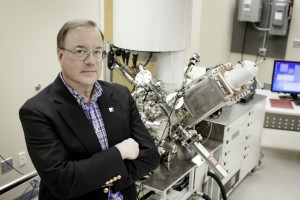It is said one hour of sunlight hitting the Earth can run the operations of mankind for one year, and Bruce Tatarchuk, Charles E. Gavin professor of chemical engineering and director of the Center for Microfibrous Materials Manufacturing, is ready to help harness that energy.
 Tatarchuk received an X-ray photoelectron spectroscopy (XPS) instrument from the U.S. Navy through the Defense University Research Instrumentation Program valued at $750,000. The XPS is a small spot x-ray photo electron spectrometer used to measure the composition of solid surfaces at their outer most atomic layers. This is used to help researchers make chemical reactions go faster at the surface. XPS is regularly used to analyze inorganic compounds, catalysts and semiconductors, among many others.
Tatarchuk received an X-ray photoelectron spectroscopy (XPS) instrument from the U.S. Navy through the Defense University Research Instrumentation Program valued at $750,000. The XPS is a small spot x-ray photo electron spectrometer used to measure the composition of solid surfaces at their outer most atomic layers. This is used to help researchers make chemical reactions go faster at the surface. XPS is regularly used to analyze inorganic compounds, catalysts and semiconductors, among many others.
Currently, there are approximately 150 similar instruments around the world, but Tatarchuk and his research team are modifying their XPS machine in order to record spectral analyses in one microsecond. This modification would make the instrument the only one of its kind in the world.
This capability will allow Auburn researchers to observe chemical reactions as they occur in real time, including the photochemical and photocatalytic splitting of water to molecular hydrogen and oxygen using sunlight. This reaction pathway has the potential to address the global challenge of how to take sunlight and directly produce storable high energy fuels for mankind’s needs.
“The XPS we plan to modify, and the new capability that it will provide, is of great interest to a wide range of researchers because of the global issues it can help us better understand and solve,” Tatarchuk said. “This device can help us figure out how to better use the sun to be a game changer across the world.”